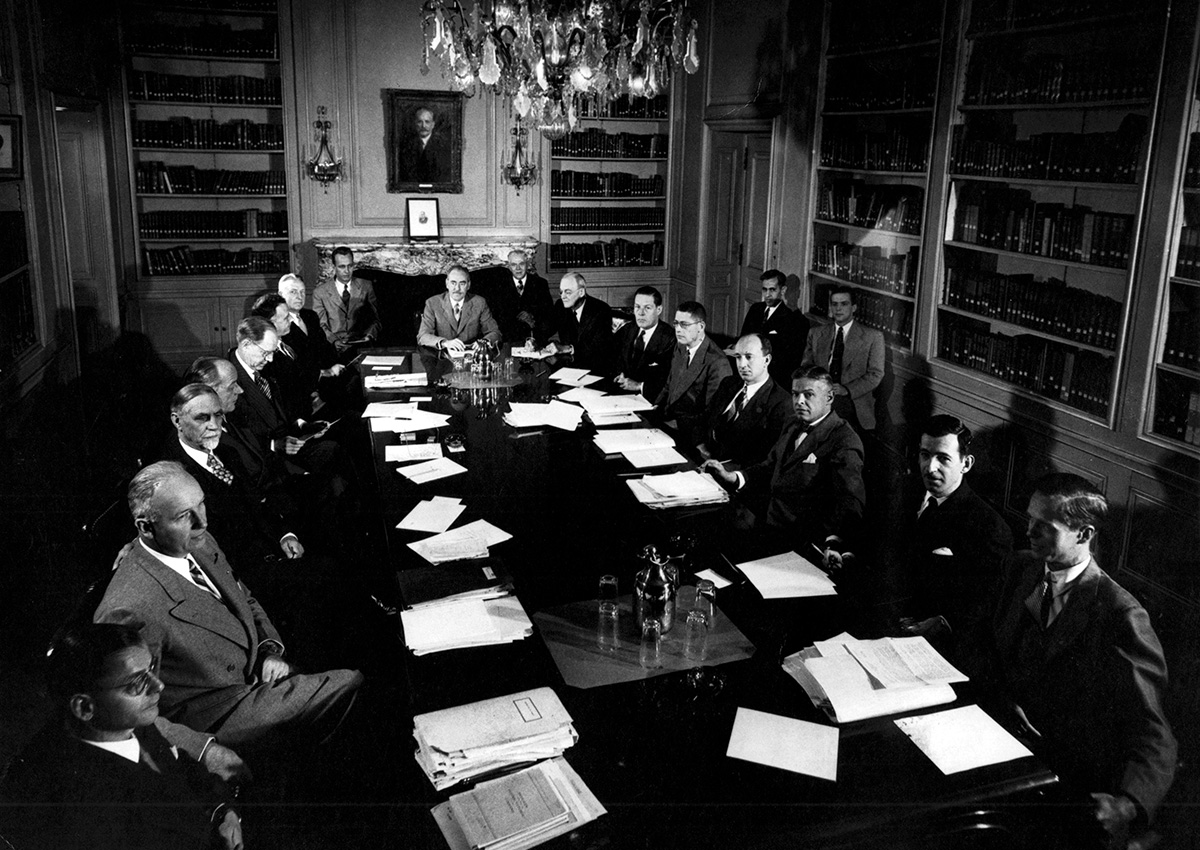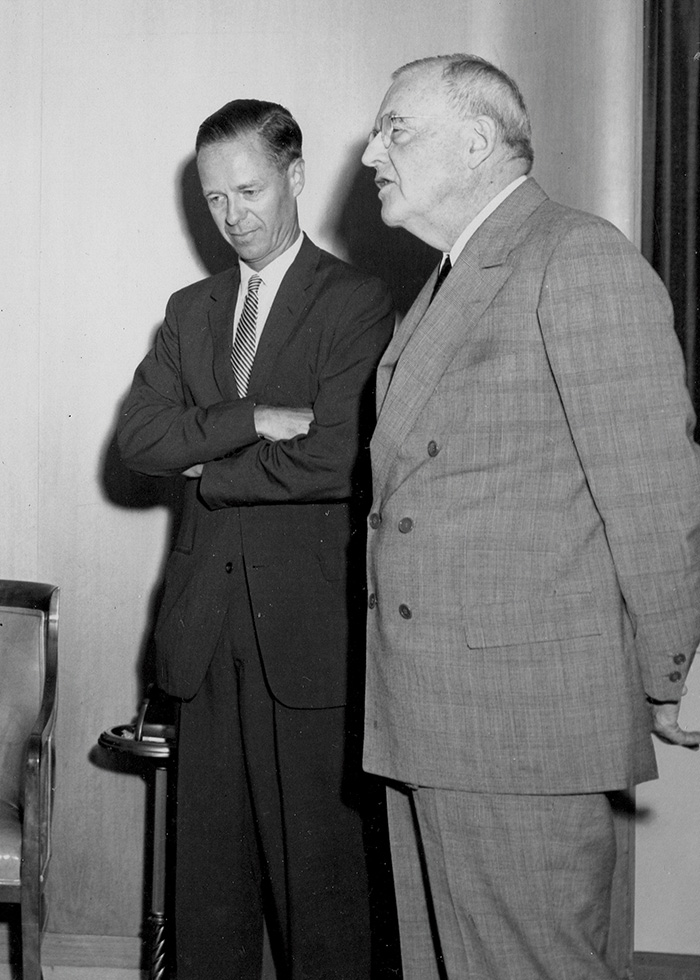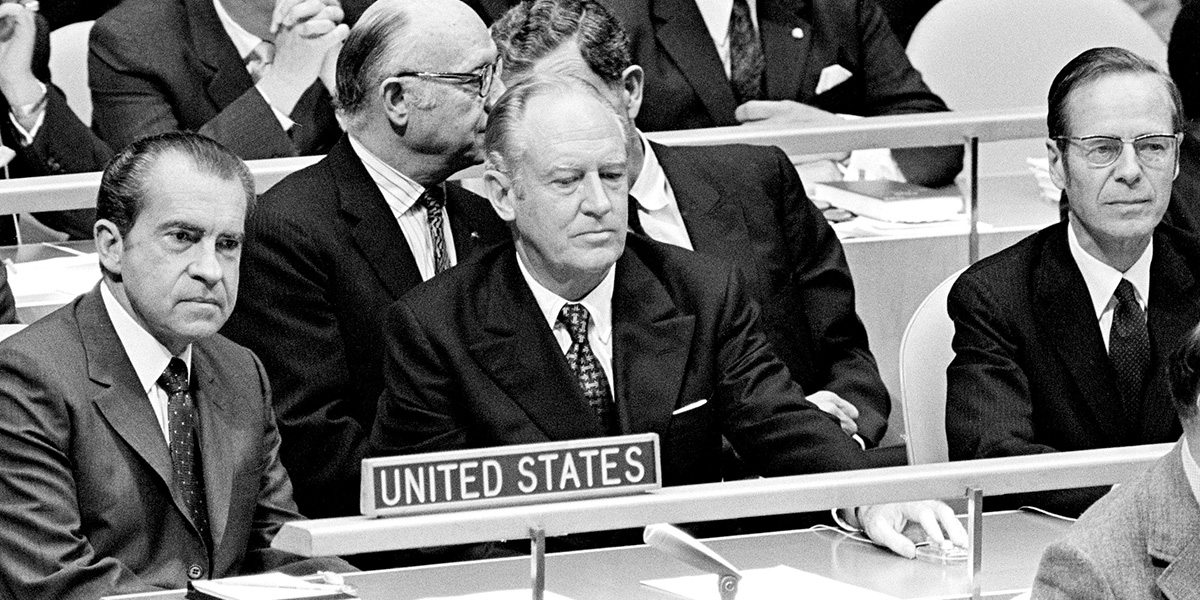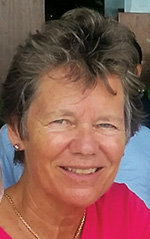A Time of “Great Malaise”
The experience of a distinguished career FSO offers a look into the dark side of mid-century America.
BY FELICITY O. YOST

A meeting at the State Department in 1950. Secretary of State Dean Acheson is at the head of the table, with John Foster Dulles, then adviser to the Secretary of State, to his left. Charles Yost is at the lower right.
U.S. Department of State

Yost, at left, with Secretary of State John Foster Dulles in 1958 at the State Department, as Dulles announces Yost’s appointment as U.S. ambassador to Morocco.
Herbert J. Meyle
After relentless FBI investigations, congressional hearings and State Department security interrogations, the prognosis was dire: It would be a time of “great malaise in the Department such as I have never seen before.” Writing this in 1980, Ambassador Charles W. Yost, my father, was referring to the federal witch hunts that began in the 1930s and lasted through the 1950s and McCarthyism.
What follows are my father’s own experiences during that tumultuous time, which arguably resonate today. He was a loyal American and successful diplomat who was subjected to repeated investigation in the search for communists in the State Department. He took good notes.
Moving into the Crosshairs
Following World War I, in the early years of the USSR, it was not unusual for young diplomats to visit that country. In fact, Yost writes in his memoirs, it would have been foolish of him to ignore the part of Europe where some of the boldest social and political experiments were occurring. As a result of his trips there in 1929 and 1933, the future Cold Warrior acquired insights into the Russian psyche.
His third trip, in 1934, would eventually have disconcerting consequences, however. Before embarking, Yost made his booking through the Open Road travel agency and, once in Moscow, attended classes at the Anglo-American Institute of the First Moscow University (all while awaiting word whether his Polish girlfriend would marry him).
He first became aware that this trip was a problem only in 1943, when his aunt reported that the FBI had questioned her about his communist leanings and attendance at a Moscow university. It was the beginning of a decadeslong investigation into Yost and his alleged communist sympathies and connections. Ten years later, the House Un-American Activities Committee (HUAC) branded the Open Road agency a “Communist Front Organization” and the university a forum for communist propaganda.
Long before HUAC’s investigation into Yost, his connection with certain questionable State Department colleagues caused his “infant file to grow like a plot of mushrooms in the darkness of the FBI vault,” as he recalled later. It all began in 1935, when the department established the Office of Arms and Munitions Control after passage of the first Neutrality Act by Congress. The Neutrality Act prohibited the export of “arms, ammunition and implements of war” from the United States to foreign nations at war and required U.S. arms manufacturers to apply for an export license. At the new State office, Yost and Joseph C. Green were tasked with registering and issuing, or rejecting, export licenses to U.S. entities engaged in defense-related trade. But because space was in short supply at the department, they were squeezed into the Western European division.
Yost’s association with individuals with whom he worked would put him in the crosshairs of FBI Director J. Edgar Hoover. There was, for instance, Noel Field, a young Quaker “who was liked by all,” as Yost recalled. Field, however, turned out to have been a Soviet spy, as did several others: Michael Straight of the department’s Eastern European division was unmasked by the Venona Project, a secret U.S. Army counterintelligence program, for recommending Yost’s recruitment to his KGB colleagues. Laurence Duggan, chief of the department’s Latin American division, who Yost reports was “considered a man of such great promise,” was an active Soviet spy during the 1930s and 1940s and died under suspicious circumstances.
Acheson directed his team to undertake a historical study that would defend against critics who blamed the administration for “losing” China.
Harry Dexter White of the Department of the Treasury was a Soviet spy who died mysteriously while being investigated by HUAC. Henry Julian Wadleigh, an economist, turns out to have passed classified department documents to the Soviets. And Alger Hiss, whom Yost found “supercilious and inclined to carp and nitpick,” was also found to have been attempting to recruit Yost to the communist cause.
KGB documents reveal that Yost was targeted for his left-leaning views, but the attempts to recruit him were done, as he later wrote, “so subtly that I was blissfully unaware.” In those days the State Department was relatively small, and employees knew each other and regularly consulted and socialized. In fact, some who turned out to have been spies belonged to a weekly foreign affairs discussion group that included Yost and was held at the home of another colleague. Until these individuals were unmasked, in some cases decades later, their department colleagues remained ignorant of their work as Soviet spies.
Success Leads to More Attention
As the witch hunts intensified with the Truman and Eisenhower Loyalty Review Board investigations of State Department employees, and Yost was placed under further scrutiny, he benefitted from the support of department mentors and friends. Yost’s FBI file shows that among those who testified on his behalf were Leo Pasvolsky and Dean Acheson. Pasvolsky was a remarkable man who is largely forgotten even though he was a principal author of the United Nations Charter. Dean Acheson, whom Yost considered “by far the best Secretary of State under whom I served,” also played an early role, nurturing Yost’s aptitude for troubleshooting, which Presidents Kennedy, Johnson, Ford and Carter would call on, too, in times of crisis.
Another key ally was found in Edward Stettinius. Though Yost recognized Secretary of State Stettinius’ limitations, he also credited him with implementing critical reforms to the antique and rigid department—reforms that survived countless reorganizations over several decades.
In January 1945, Secretary Stettinius offered Yost the position of executive secretary of his new “Policy Committee,” which would evolve into the Policy Planning Staff under Secretary George Marshall and George Kennan. Yost’s additional duties included preparing a daily two-page summary of cables, reports, memoranda, Allied messages and “magic” intercepts for President Roosevelt. Yost’s summaries, which became a standard department exercise, resulted, he later wrote, in his transformation into “one of the best-informed individuals in Washington, except about purely military planning” during the last year of the war.
Stettinius also nurtured Yost’s expertise in U.N. affairs by directing him to assist with writing the crucial Chapters VI and VII of the U.N. Charter during the Dumbarton Oaks Conference, and assigning him as his aide and principal drafter at the 1945 San Francisco Conference. Yost served Secretary of State James Byrnes, who replaced Stettinius in July 1945, at the Potsdam Conference before being posted to Thailand as U.S. Minister.
Yet Yost’s revolving high-profile positions had an unwelcome result—namely, the renewed attention of FBI Director Hoover. As a result of President Truman’s Executive Order 9835 (also known as the Loyalty Order, which established the Federal Employees Loyalty Program in 1947), anonymous accusations were being made about many employees and would end the careers of an untold number. Yost’s own career would soon hang in the balance.

From left, President Richard M. Nixon, Secretary of State William P. Rogers and U.S. Ambassador to the United Nations Charles Yost at the U.N. General Assembly in 1970.
United Nations / Yutaka Nagata
The Perils of Dangerous Thoughts
In 1949 it became apparent that U.S. policy on China was in disarray. As the Chinese civil war was raging, the Truman administration found itself caught between the department’s “China hands,” those who were recommending liaising with Mao’s communists because they would most likely prevail, and the Republican-led “China Lobby,” those who were pushing for expanded U.S. support for Chinese leader Chiang Kai-shek.
Acheson directed his team to undertake a historical study that would defend against critics who blamed the administration for “losing” China. The result was the China White Paper, which some historians assert was principally authored by Yost. It caused a firestorm. It also renewed Republican assertions that the Democrats had in fact “lost” China, to which Yost retorted: “Chiang Kai-shek lost China because he was in charge.”
Despite evidence presented to the loyalty boards (see below) supporting their patriotism and independence, including Yost’s testimony for John S. Service, most of the China experts at State were fired or forced to resign. As a result, Yost believed, FSOs who would have helped the United States navigate China affairs—and who could have predicted and possibly prevented U.S. entry into the Korean and Vietnam wars, as well—had now been eliminated. But the situation was about to get worse. In 1950 Senator Joseph McCarthy claimed that he had a list of “known communists” in the State Department.
For Yost, the loyalty boards and McCarthy era represented a time of “sickness that disfigured and weakened America.” And in 1950, prior to assuming his duties as minister to Greece, he found there would be no letup. FBI Director Hoover ordered a new investigation into Yost, admonishing his agents: “This is one of the oldest pending LGE [Loyalty of Government Employees] Cases. Further delay will not be tolerated.”
The FBI subsequently put Yost’s house under surveillance and tapped his phone; spoke with his family, neighbors and former professors; contacted credit bureaus, the passport office and the Washington, D.C., Metropolitan Police; and questioned Yost’s colleagues on three continents. When Conrad Snow, chairman of the Department of State Loyalty Security Board, interrogated him, Yost retorted he was “bitter and indignant” that his loyalty was being questioned. Friend, diplomat and Nobel Peace Prize winner Ralph Bunche echoed that sentiment when his loyalty was similarly questioned.
The 1953 election of President Dwight D. Eisenhower brought no respite. In his maiden speech to department employees, Secretary of State John Foster Dulles stated that he expected loyalty. It soon dawned on Dulles’ staff that neither the Secretary of State nor the president would reciprocate. What’s more, Eisenhower replaced Truman’s Order with Executive Order 10450, which examined character as well as political beliefs.
Yost’s revolving high-profile positions had an unwelcome result—namely, the renewed attention of FBI Director Hoover.
Within a month, State’s Office of Security questioned Yost while he was on home leave. The officials called it an “interview and not a hearing,” but it was neither. It was an interrogation. They informed Yost that source names would be withheld, and that source statements would become part of his official file. Two months later, the loyalty board summoned him back from Greece for another round.
Fortune Smiles
For many years, department colleagues wondered how Charles Yost had survived the Truman and Eisenhower purges. The answer lies in Yost’s dictum that the basis for a successful Foreign Service career was shaped by “who you knew, what you knew, and luck.” In addition to department Secretaries and former bosses such as Ambassador-at-Large Philip Jessup and Ambassador Llewellyn “Tommy” Thompson, the “who,” in this case, were two ultraconservative Republicans whose support during that era proved crucial: Hiram Bingham III and the aforementioned John Foster Dulles.
Senator Hiram Bingham III was the father of Yost’s fellow diplomat and friend Hiram (Harry) Bingham IV. When the senator became chairman of the Loyalty Review Board, he personally urged J. Edgar Hoover to declare Yost “eligible on loyalty” to remain in the Foreign Service. (Hoover backed down but did not abandon his determination to have Yost discharged or jailed.) Yost’s long-standing connection to the Dulles family began in their hometown of Watertown, New York. The minister who married Yost’s parents, Allen Dulles, was the brother-in-law of one Secretary of State, Robert Lansing (responsible for recommending a diplomatic career to Yost), and the father of John Foster Dulles.
Family loyalty may be the reason why Foster Dulles was motivated to call Yost an exceptional diplomat and loyal American, and why his sister, Eleanor, testified that Yost was “as loyal as President Eisenhower.”
Lest We Forget
The year 1969 would be the last time Yost was subjected to an FBI background check—and the issue of his alleged communist ties would once again arise. He had been nominated as ambassador to the United Nations, the first FSO to achieve that distinction. The irony that President Richard Nixon, a former member of HUAC who spearheaded the investigation of Alger Hiss, made the appointment was not lost on my father. Yost, however, was livid when in making his announcement of the U.N. appointment, Nixon added that he had chosen to look past the Yost- Hiss association—thus raising the long-forgotten issue of Yost’s alleged communist ties for the press.
As Yost recalls in his memoirs, these witch hunts left deep scars, which some, including he, never got over, and from which the Foreign Service did not recover for many years. In an unpublished 1964 paper, “The Social Costs of the Loyalty Programs,” Rutgers Professor of Political Science Paul Tillett quotes FSOs who lamented that in the State Department the process resulted in a Foreign Service that “was dying at the roots and suffering attrition.”
In his memoirs, Charles Yost issued a warning we would do well to heed in the 21st century. Stating that the “monomania and the intemperance of the Radical Right [was] a much more serious, because more indigenous, threat to American democracy,” he observes: “There lies buried not too deep under the skin of American democracy a strain of bigotry and know-nothingism that demagogues can tap with frightening ease; leaders concerned for liberty should be eternally vigilant against it.”
Loyalty Oaths in America
Oaths of loyalty are an old and honored American tradition. The Constitution provides in Article VI that “the Senators and Representatives … and the Members of the several State Legislatures, and all executive and judicial Officers, both of the United States and of the several States, shall be bound by Oath or Affirmation, to support this Constitution.” The Pledge of Allegiance, a loyalty oath that dates from the Civil War, is regularly recited in public forums.
The loyalty oaths that proliferated after World War II, however, added a condemnation of communism to the affirmation of American ideals.
Under the Taft-Hartley Act (1947), labor union leaders had to swear that they were not communists and did not favor the overthrow of the government. Different levels of government soon levied similar requirements on various targets, including residents of federally assisted public housing; employees of the state of California, the city of Chicago, the county of Los Angeles and the Massachusetts Institute of Technology; as well as students in New York State high schools and students receiving aid under the National Defense Education Act.
President Harry S Truman’s loyalty program, imposed by executive order on March 21, 1947, required every federal civilian employee to submit to a loyalty investigation carried out by loyalty boards established in every government agency. A loyalty board could order the dismissal of any employee if it found “reasonable grounds” to believe that the employee was disloyal. Those grounds could include membership or “sympathetic association” with any group or “combination of persons” that the U.S. Attorney General designated as subversive. Employees under investigation had no right to counsel and could be denied access to the evidence against them.
President Dwight Eisenhower’s program, imposed by executive order in March 1953, shifted the focus from purging the disloyal to purging security risks, not just in certain agencies but across the government. Security risks were broadly defined, including those whom the government saw as social misfits—persons who were “not reliable or trustworthy” or whose conduct was considered “infamous, dishonest, immoral, or notoriously disgraceful.”
The results of these programs are hard to pin down. Most of the investigative files have been destroyed, and there are gaps in the record. Landon Storrs, in her 2012 book, The Second Red Scare, estimates that from 1947 to 1953, 4.75 million employees submitted loyalty forms to investigators. Between 1947 and 1956, says Storrs, 2,700 federally employed civilians, 750 military personnel and 5,400 contract workers (mostly in port security) were dismissed; many others resigned before investigations were complete. An unpublished 1964 study by Rutgers Professor Paul D. Tillett estimated that 6.5 million people were investigated, leading to thousands of dismissals, with consequent loss of livelihood and “suicides, mental illness, and the breakup of families.”
For all their sweep and personal devastation, the loyalty investigations caught not a single spy. In time, the U.S. Supreme Court and lower courts invalidated much of the federal loyalty program, and many other loyalty oaths, as failing to protect due process and infringing on freedom of speech and association.
—Harry W. Kopp
Read More...
- “Career Vs. Conscience,” The Foreign Service Journal, July 1951
- “Only in Rejection Could There Be Vindication,” by John Service, The Foreign Service Journal, March 1974
- “The McCarthy Years Inside the Department Of State,” by John W. Ford, The Foreign Service Journal, November 1980




